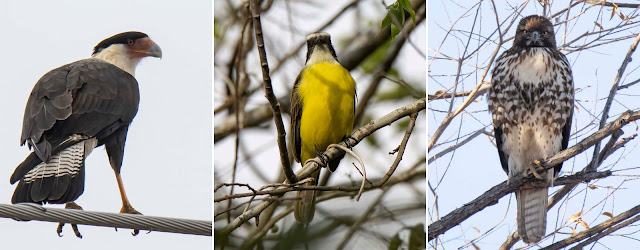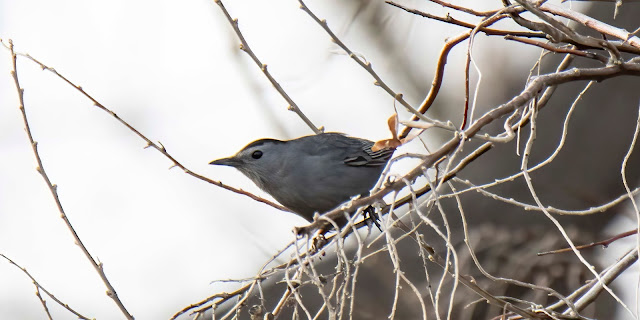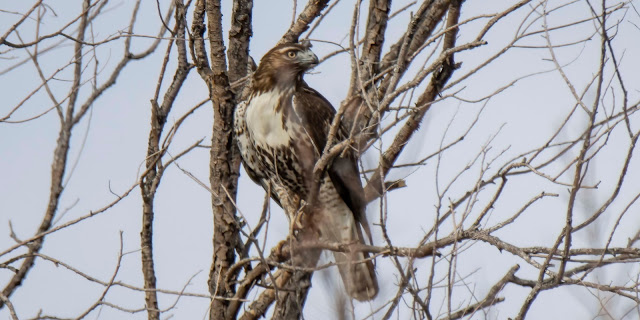 |
| A good couple of days: Crested Caracara, Social Flycatcher, Rough-legged Hawk |
Social Flycatcher
A Social Flycatcher had been repeatedly spotted at a very specific spot (the "Land Bridge") on the campus of the University of Texas – Rio Grande Valley.
 |
| When I saw "UTRGV" on eBird, I didn't know what it meant |
I made my way to campus and found it eerily quiet. School had not yet started after the holiday break, so no one was there.
 |
| The campus is on the border and has lots of water |
There were several other birders there, so I knew I was where I needed to be.
The weather was quite different than SANWR. It was 80°F, sunny and windy. Luckily, I was dressed in layers that I could take off and I had some sandals in the car. My feet appreciated the break from lace-up shoes. The temperature wasn't an issue, but the wind was. We heard a bird that was possibly the Social Flycatcher, but nothing appeared.
There were some other birds in the area: Another Green Kingfisher ...
A Tropical Kingbird ...
 |
| A bright bird being upstaged by the Social Flycatcher |
A Snowy Egret ...
 |
| So graceful |
An Anhinga ...
 |
| A beautiful male drying its wings |
Some Black-bellied Whistling Ducks ...
 |
| They use those giant feet to balance on narrow branches and wires |
The wind got stronger and stronger and the bamboo in the thicket was swaying wildly. I really doubted the bird would come out – so much so that I gave up and walked back to my car. Close to the parking lot, I ran into one of the other birders and we spoke briefly.
 |
| Maintaining balance in a stiff breeze |
I asked if she had given up and she said that she was just looking around and her husband would call her if the bird appeared. I wished her luck and continued on to my car. Just as I unlocked the door, she called out that the bird had appeared.
 |
| There it was in the trees! |
I rushed back and was rewarded handsomely.
 |
| Native to Central and South America |
 |
| Social Flycatcher range |
What a beautiful bird!
With a range very similar to the Bat Falcon, this loud chatty (hence "social") bird looks like a slightly smaller Great Kiskadee with much smaller bill.
A member of the large Tyrant Flycatcher family, it lives in parts of Central and South America.
Once again, I might see this bird in Costa Rica.
About six inches long, the Social Flycatcher has a dark grey head with a strong white eyestripe and a usually concealed orange-to-vermilion crown stripe. The upper parts are olive-brown and the wings and tail are brown with only faint rufous fringes. The underparts are bright yellow and the throat is white.
 |
| I wonder how these birds feel about being celebrities |
They like to perch openly in trees, high above the ground, from which they fly to catch insects in flight.
 |
| It was quiet when we saw it |
They also eat berries, aquatic invertebrates, tadpoles and, occasionally, small fish. They have been observed to forage peacefully alongside Common Marmosets in the undergrowth, maybe even cooperating with them in flushing prey from hiding.
But, this bird won't find any Marmoset buddies here in Texas!
I got some great photos.
 |
| I didn't stay long, but I was there long enough to get photos |
It was worth the trip.
On my way back to my hotel, I considered stopping again at SANWR to see the Bat Falcon one last time at its sunset appearance.
 |
| Would it come out again? |
Photos would be no better than the night before.
I was tired and had to leave early the next morning to head toward home. So, I passed on by.
Maybe a bit lazy, but ...
This is where needing to get home for the PRSA meeting was frustrating. If I had had the day I lost, I could have tried out a few other areas where other rare (or unique to the area) birds had been sighted: Hook-billed Kites (one had been seen in SANWR, but it didn't show when I was there; several were routinely sighted in another nearby Park), Aplomado Falcons at Laguna Atascosa (I didn't see them when I was there before, but they are seen frequently), a Crimson-collared Grosbeak at a nearby garden and maybe a shot at photographing a Plain Chachalaca.
Driving to Carlsbad
My first stop was to be Carlsbad Caverns to see the Blue Mockingbird. Originally I didn't plan on making the 12-hour drive in one day. I was going to stay in Fort Stockton, Texas, and get up early the next morning to head to Carlsbad. That was risky because the Blue Mockingbird was most often seen around sunrise.
The first half of my drive was along the border from McAllen where my hotel was to slightly north of Del Rio where I headed inland.
In those less than 400 miles I saw no less than 20 marked Highway Patrol and 10 Border Patrol vehicles plus about six camouflaged jeeps with armed occupants (official or vigilante, I do not know).
It didn't really inspire frequent stops.
I did make a brief roadside stop to click two Harris's Hawks, one uninterested in passing cars ...
... and, one pretty interested in me as I stepped out of my car to take pictures ...
 |
| Showing off its fluffy white tail vent |
... and a Crested Caracara ...
 |
| Another fairly common far south raptor |
But, besides that, I soldiered through.
 |
| Next gas |
Carlsbad
I got to my hotel after dark and crashed. I had another long day ahead of me.
I managed to get up and out early enough to reach the Rattlesnake Springs Picnic Area in Carlsbad Caverns National Park before 7:00 a.m.
 |
| Carlsbad Caverns National Park |
The picnic area is not in the main part of the park; rather it is reached by a separate road a couple of miles south of the main road to the caverns.
There were cars in the parking lot, but no people to be seen. Was this another case of "it's really easy to find the spot to see the bird" that is not easy?
Almost. But, I saw another person, who pointed me in the right direction – a short path to an area behind a thicket where several photographers were staked out.
No one had seen anything yet. Two had been there the day before for eight hours and saw nothing (they said it was windy the day before; it was still this morning). Yikes! Was this a fool's errand?
But, we watched and waited. I knew that the Blue Mockingbird liked hackberry bushes and the odds of a photo in the open were slim (I had seen other people's thicket photos). But, hope springs eternal.
 |
| This might be the best I could hope for |
There was a false alarm when a Gray Catbird popped out.
 |
| Not what I was hoping for |
And, then, within 15 minutes, the bird started hopping around in the deep thicket. Not ideal, but I just got my 708th Lifer!
 |
| Another goal reached |
Then, bingo! A brief stop on a fairly open branch. Yay!
 |
| Spectacular! Better than anticipated |
 |
| Blue Mockingbird range |
According to Audubon: Only distantly related to our Northern Mockingbird, this slaty-blue Mexican specialty is an elusive skulker of dense thickets. It has strayed north very rarely into southern Arizona, where some individuals have been known to linger for several months. This location in New Mexico was quite far afield.
 |
| Although far from home, this bird seems to have settled happily in New Mexico |
Uniformly blue on its back, tail, wings, head and underbelly, it has a black "mask" surrounding its reddish-brown eyes. It has a rather long, slightly graduated tail and dark blue streaks over its breast. Its bill is long, thin and slightly curved, and its legs and feet are black.
 |
| A real beauty |
A few good shots and I was on my way.
 |
| Some Mourning Doves near the Rattlesnake Picnic Area exit |
On the Way Home
But, where to? I had no firm plan because I didn't know how long it would take to find the Blue Mockingbird. I drove the nature loop road in the main part of Carlsbad Caverns, but saw nothing but a Mule Deer ...
... and a couple of Lark Buntings ...
 |
| A female Lark Bunting |
I didn't try to tour the caverns because I have been fairly recently and I was still pretty far from home.
Bosque del Apache National Wildlife Refuge
I drove north and then cut through the mountains over to Bosque del Apache National Wildlife Refuge.
 |
| Sunset in Bosque del Apache |
Bosque is famous for its Sandhill Cranes and I have visited several times.
I got there late, but had a nice afternoon-to-dusk drive-through.
The light was lovely and there were some – but not a lot – birds.
 |
| Pretty scenery |
I managed to score repeats on a number of birds, but nothing new. Sightings included:
A Bald Eagle in a very sticky tree ..
.
 |
| I usually see Eagles at Bosque and they are always far away |
A couple of American Kestrels, sitting ...
... and flying ...
 |
| A gorgeous male American Kestrel |
 |
| These guys are very photogenic |
Gambel's Quail ...
 |
| Love the topknot |
Northern Pintails ...
 |
| This is a female |
Lesser Scaups ...
 |
| A dramatic take-off |
A gorgeous Rough-legged Hawk ...
... that looked like it ruled the world ...
 |
| Not a bird to mess with |
... And, another one that was just ignoring me ...
And, a rather small contingent (compared to previous visits) of Sandhill Cranes ...
 |
| This one is banded |
... and Snow Geese ...
 |
| Lots were flying, but I don't know where they were going |
They were mixed together, eating in the marshy fields ...
 |
| Feeding together |
... and flying against a mountain backdrop ...
 |
| More Geese coming in |
It wasn't my best visit to Bosque, but I think all the driving had caught up with me. I was so tired that I didn't even stop when I saw a large group of Javelinas in a field (in my defense, it was after sunset) and I ate dinner from McDonald's because it was next to my hotel.
Sleep was welcome.
 |
| Time to turn in |
Maxwell National Wildlife Refuge
My final stop was an oldie, but a goodie: Maxwell National Wildlife Refuge. It's fairly close to home and on my route when returning from anything in New Mexico.
Although unimpressive when it comes to scenery (it looks like the surrounding cattle farms), it's usually good for raptors.
In the past, it's been mainly Bald Eagles. This time, I saw a small group of Sandhill Cranes ...
A very dark Red-tailed Hawk ...
 |
| Every time I got close, it flew away |
And, a very light Prairie Falcon ...
 |
| The variety of raptors at Maxwell is impressive |
But, it was mainly Northern Harriers.
This included a couple of hunting females ...
 |
| That white band on the tail is another |
... gliding over the lake ...
 |
| This one looped by multiple times |
... occasionally hovering over prey ...
 |
| Looking for a snack |
... and finally catching something
 |
| This one had a Mouse or a Vole |
It was sunny and calm, the Harrier was close and I was able to get out of my car for a clear shot without frightening the bird. Imagine my disappointment when the shots came out soft.
 |
| This photo should have been so much better |
This was a final straw. I had been having trouble with my lens losing contact with my camera, requiring me to uncouple and recouple it again. And, I was feeling that some (but, oddly, not all) of my shots were softer than they should be.
I shipped the lens and camera off to Tamron for repair and calibration. I hope it comes back better.
 |
| Good, sharp focus is important; Red-tailed Hawk |
While it's been gone, I borrowed Scott's Nikon and his Tamron lens (same one, just for a Nikon). Those shots were perfect (*chef's kiss*).
My fingers are crossed that's what I'll get when my baby comes home. Otherwise, do I have to get a new lens or (gasp!) switch to Nikon? We'll see.
So, even though it was a rushed trip, it was success.
I got ten new birds and a nice escape from being cooped up in the house. I still need to go back to south Texas to see more. But, I accomplished a lot.















